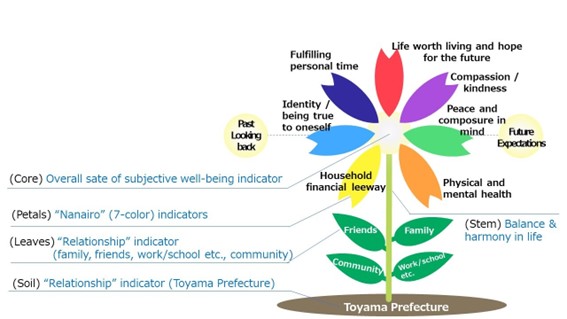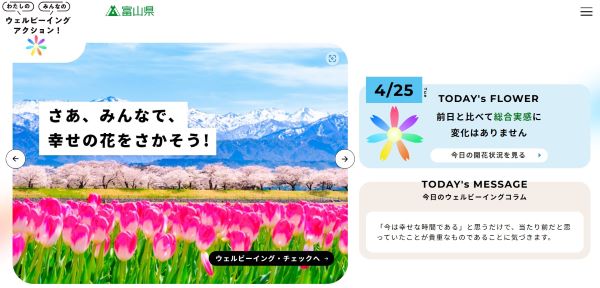
'Well-being Indicators' - The Pillar of Toyama Prefecture's Growth Strategies

The City of Toyama and Tateyama Mountain Range
Toyama Prefecture in Japan has a unique initiative that uses well-being as a pillar of its growth strategy. In this article we have a look at the indicators created to measure well-being, and how they are being used to connect to growth.
**
On January 6, 2023, Toyama Prefecture announced that it had developed its own indicators of well-being. Toyama is a prefecture in Japan's Hokuriku Region, with a population of about one million people. Located on the Sea of Japan (western) side of the main island of Honshu, it is known for its abundant nature, with major features being Toyama Bay which has a depth of 1,000 meters and the Tateyama Mountain Range with soaring elevations of around 3,000 meters.
Toyama's well-being indicators were designed to grasp people's actual perceptions from various angles based on their answers to survey questions. The special flower-shaped design used to display the findings is another interesting feature. This issue of the ISHES Newsletter introduces Toyama's own approach, unique in the world, to make well-being a pillar of its growth strategies.

Figure 1. The City of Toyama and Tateyama Mountain Range
Well-being - A key to the future
The Governor of Toyama, Hachiro Nitta, inaugurated in November 2020, wrote about the importance of well-being on the prefecture's website: "Today, circumstances surrounding society and economy have been changing by the minute and the future is uncertain. We are entering a time in which it is difficult to predict the future. In this situation, I believe that aiming to improve well-being enhances the vitality of the economy and society, leading to further growth. In Toyama, we would like to make well-being a pillar of our new growth strategies, as we develop policies for industry and human resources."
It was in February 2022 that Toyama's Growth Strategy, referred to in the Governor's original message, was released. In the strategy, well-being is explained as follows, citing the World Health Organization (WHO) constitution: "Health is a state of complete physical, mental and social well-being and not merely the absence of disease or infirmity." Based on this idea, the prefecture placed well-being at the core of its Growth Strategy, explaining that well-being is "being able to live happily in your own way," and "being able to be fully alive, considering not only outward measures such as income and health, but also, intangibles such as career and position in society, and connections with the people around you and your local community."
A public perception survey on well-being was conducted in September 2022, and based on the results, Toyama developed its well-being indicators, which were announced in January 2023.
Toyama's Well-being Indicators
There are generally two ways to evaluate happiness and well-being. One is to use objective data such as statistics on the unemployment rate. The other is to use subjective data based on surveys of people's actual perceptions. Toyama's well-being indicators are the latter. The survey questions for evaluating the well-being are divided into three categories of indicators: "Overall Well-being," "Individual Elements," and "Relationships."
One of the Overall Well-being Indicators is the overall state of subjective well-being. The present state of subjective well-being is evaluated by asking respondents to rate their present well-being state on an 11-point scale, from zero (the worst possible life) to ten (the best possible life). This method is known as the "Cantril ladder," which is used in the "World Happiness Report" by the United Nations. Toyama's well-being indicators evaluate not only the present state but also the state of subjective well-being by looking back at the "past self" of five years ago, and forward, to well-being expectations about the "future self" five years ahead. Questions about life harmony and a sense of balance are also included in the survey.
Indicators by Element are referred to as Nanairo Indicators (meaning "seven colors" in Japanese), evaluating people's actual perceptions in seven areas: (1) physical and mental health, (2) household financial leeway, (3) peace and composure in mind, (4) identity/being true to oneself, (5) fulfilling personal time, (6) life worth living and hope for the future, and (7) compassion/kindness. Multiple questions are set by category. For example, regarding "physical and mental health," two questions are set, such as "You feel physically healthy," and "You feel mentally healthy." To answer these questions, respondents choose from four options: "Yes," "Likely yes," "Likely no," or "No."
For the Relationships Indicator, respondents choose one answer from four options, as they do for the Nanairo (7-color) Indicators, about the relationship between themselves and family or society, including relationships with family, friends, workplace and school, community, or Toyama Prefecture. On the relationship with family, for example, multiple questions are asked about the relationship with family and friends such as "Your family understands and respects your opinions and sense of values" and "You feel that your family will help you when you are in trouble or in need."
Thus, the indicator captures the responses about each person's well-being from multiple dimensions, including actual feelings in different areas such as mind and body or economy, as well as the sense of connection that is considered to be essential in examining well-being, in addition to the sense of current overall status.
Flower design helps visualize the results
A multifaceted consideration of well-being is absolutely essential. Some may be concerned that the survey results can be confusing since the three main indicators each have several questions. The valuable survey findings would be wasted if they were not being incorporated into future initiatives. On that point, Toyama Prefecture attempted to make the results easier to understand by using a flower design as a visual aid.
The OECD's Better Life Index is another example that uses a flower design to represent well-being. It uses only the flower petals, but Toyama Prefecture's well-being indicators use the whole flower - soil, stem, four leaves, seven petals, and core at the center of the petals. Let's look at which indicator each part represents.

Figure 2 Flower design
Source: Toyama Prefecture
Core (center) of petals: Overall state of subjective well-being (on the left is perception looking back, on the right is looking forward)
Seven petals: "Nanairo" (each of the seven colors has different meaning, as shown)
Four leaves: Family, Friends, Work/school, Community (Relationships)
Stem: Balance & Harmony in life (part of Overall Well-being)
Soil: Toyama Prefecture (Relationships)
The design presents at a glance the status of diverse aspects of well-being, from soil as a foundation (connection with Toyama Prefecture) to stem (harmony and balance), leaves (connection with family and local community), and the flower at the top (overall state and subjective well-being of each element).
Future prospects
The indicators were first announced in January 2023, and ongoing surveys are planned, to be used as basic data for policy-making. Improvements in statistic numbers and other objective data have been used in the past as indices to evaluate policies, but there are also plans to use subjective data to measure whether or not policies actually lead to greater happiness for the prefecture's residents.
Some of the prefecture's various programs are being selected to test the use of well-being indicators. "Nanairo" (7-color) Indicators and "Relationship" Indicators can be used at the planning stage to clarify a program's aims. Which well-being needs are being targeted for improvement, and for whom? When considering these things, icons such as the colored petals and leaves can help to visually convey the meaning, just as we can see with the icons being used for each of the UN Sustainable Development Goals (SDGs).
On March 20, 2023, International Day of Happiness, Toyama Prefecture launched a new "Well-being Action" website. Users can answer 47 questions to discover the status of their well-being, expressed by the size of the seven petals, leaves, and stems. Besides seeing survey results for the whole prefecture, people can become more aware of their own individual well-being by seeing their own results. The website also allows users to register well-being related projects being done by individuals, businesses, and organizations.

Toyama Prefecture's website
Toyama Prefecture's initiatives have made well-being a central pillar of its growth strategies. We look forward to learning more about how things progress in the future.




